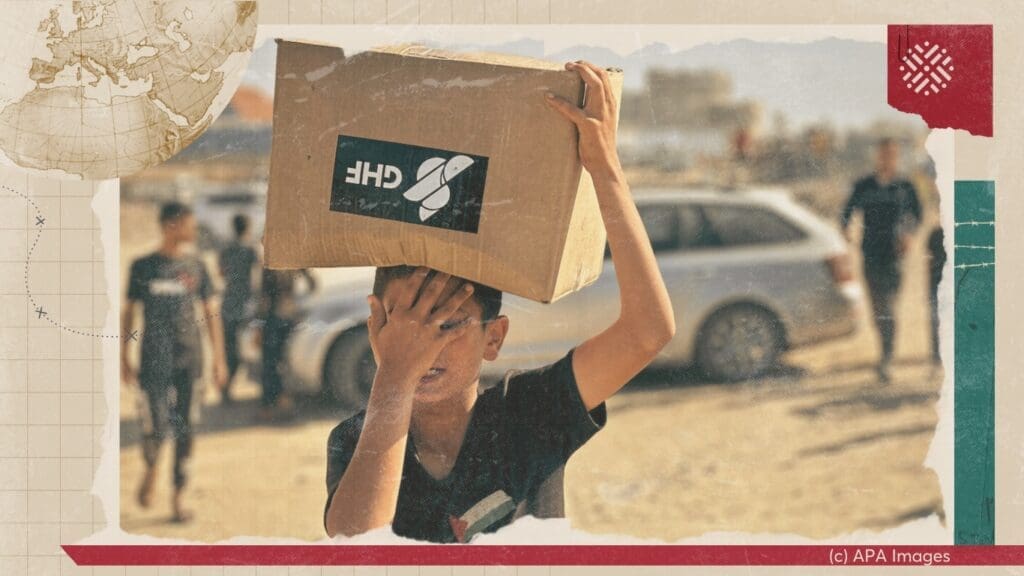- Topics
-
Topics
See our analysis on civil society and how it shapes culture, politics, and policies
Read our insights on the shifting political landscape and what it means for Palestine
Learn more about the policies and practices shaping the Palestinian economy
Strengthen your understanding of the unique conditions for Palestinian refugees across the Middle East
-
- Analysis
-
Analysis
In-depth analysis on existing or potential policies that impact possibilities for Palestinian liberation.
Insights and perspectives on social, political, and economic questions related to Palestine and Palestinians globally.
Concise analysis into a specific policy, its background and implications.
Commentary that brings together insights from multiple analysts.
Compilations of past Al-Shabaka works surrounding a specific theme.
Longer-form, ad hoc projects that seek to confront research questions outside the scope of our regular analysis.
A policy-driven research initiative by Al-Shabaka: The Palestinian Policy Network.
Our monthly webinar series that brings together Palestinian experts.
Featured
The Israeli regime’s ongoing genocide in Gaza has exposed the failure of international legal frameworks to protect civilians, marking an unprecedented breakdown in the protective function of international law. While the Genocide Convention obligates states to prevent and punish genocide, and the Geneva Conventions establish protections for civilians under occupation, these mechanisms have proven powerless without the political will to enforce them. In this context, eight Global South states—South Africa, Malaysia, Namibia, Colombia, Bolivia, Senegal, Honduras, and Cuba—have launched the Hague Group, a coordinated legal and diplomatic initiative aimed at enforcing international law and holding the Israeli regime accountable. This policy memo examines the group’s efforts to challenge entrenched Israeli impunity. It highlights the potential of coordinated state action to hold states accountable for violating international law, despite structural limitations in enforcement. Munir Nuseibah· Jul 8, 2025On Thursday, June 19, 2025, Israeli Prime Minister Benjamin Netanyahu stood in front of the aftermath of an Iranian strike near Bir al-Saba’ and told journalists: “It really reminds me of the British people during the Blitz. We are going through a Blitz.” The Blitz refers to the sustained bombing campaign carried out by Nazi Germany against the UK, particularly London, between September 1940 and May 1941. With this dramatic comparison, Netanyahu sought to elicit Western sympathy and secure unconditional support for his government’s latest act of military escalation and violation of international law: the unprovoked bombing of Iran. This rhetorical move is far from new; it has become an enduring trope in Israeli political discourse—one that casts Israel as the perennial victim and frames its opponents as modern-day Nazis. Netanyahu has long harbored ambitions of striking Iran with direct US support, but timing has always been central. This moment, then, should not be viewed merely as opportunistic aggression, but as part of a broader, calculated strategy. His actions are shaped by a convergence of unprecedented impunity, shifting regional dynamics, and deepening domestic political fragility. This commentary examines the latest escalation in that context and discusses the broader political forces driving it.
Munir Nuseibah· Jul 8, 2025On Thursday, June 19, 2025, Israeli Prime Minister Benjamin Netanyahu stood in front of the aftermath of an Iranian strike near Bir al-Saba’ and told journalists: “It really reminds me of the British people during the Blitz. We are going through a Blitz.” The Blitz refers to the sustained bombing campaign carried out by Nazi Germany against the UK, particularly London, between September 1940 and May 1941. With this dramatic comparison, Netanyahu sought to elicit Western sympathy and secure unconditional support for his government’s latest act of military escalation and violation of international law: the unprovoked bombing of Iran. This rhetorical move is far from new; it has become an enduring trope in Israeli political discourse—one that casts Israel as the perennial victim and frames its opponents as modern-day Nazis. Netanyahu has long harbored ambitions of striking Iran with direct US support, but timing has always been central. This moment, then, should not be viewed merely as opportunistic aggression, but as part of a broader, calculated strategy. His actions are shaped by a convergence of unprecedented impunity, shifting regional dynamics, and deepening domestic political fragility. This commentary examines the latest escalation in that context and discusses the broader political forces driving it. Yara Hawari· Jun 26, 2025Launched on May 26, 2025, and secured by US private contractors, the new Israeli-backed aid distribution system in Gaza has resulted in over 100 Palestinian deaths, as civilians navigated dangerous conditions at hubs positioned near military outposts along the Rafah border. These fatalities raise grave concerns about the safety of the aid model and the role of US contractors operating under Israeli oversight. This policy memo argues that the privatization of aid and security in Gaza violates humanitarian norms by turning aid into a tool of control, ethnic cleansing, and colonization. It threatens Palestinian life by conditioning life-saving aid, facilitating forced displacement, and shielding the Israeli regime from legal and moral responsibility. It additionally erodes local and international institutions, especially UNRWA, which has been working in Gaza for decades.
Yara Hawari· Jun 26, 2025Launched on May 26, 2025, and secured by US private contractors, the new Israeli-backed aid distribution system in Gaza has resulted in over 100 Palestinian deaths, as civilians navigated dangerous conditions at hubs positioned near military outposts along the Rafah border. These fatalities raise grave concerns about the safety of the aid model and the role of US contractors operating under Israeli oversight. This policy memo argues that the privatization of aid and security in Gaza violates humanitarian norms by turning aid into a tool of control, ethnic cleansing, and colonization. It threatens Palestinian life by conditioning life-saving aid, facilitating forced displacement, and shielding the Israeli regime from legal and moral responsibility. It additionally erodes local and international institutions, especially UNRWA, which has been working in Gaza for decades. Safa Joudeh· Jun 10, 2025
Safa Joudeh· Jun 10, 2025
-
- Resources
- Media & Outreach
- The Network




Back to the Future: The Great March of Return
The Great March of Return – which began on March 30 and has not yet ended – has shuffled the cards and brought crucial questions to the fore regarding the essence of the Palestinian cause as well as the status of the Gaza Strip. Despite the bleak reality of life in Gaza, which Israel’s siege will, with international and local collusion, soon render uninhabitable, a new awareness is emerging.1
This new awareness is undercutting the long-dominant policies of the current right-wing leadership and the superficial “opposition” represented by what I call the Stalinist left – that is, both the Popular and Democratic Fronts for the Liberation of Palestine, the Palestinian People’s Party, the Palestinian Democratic Union and, to some extent, the Palestinian National Initiative. These parties have so far failed to emerge from their intellectual subordination to the now defunct Soviet Union and continue to depend financially on the right-wing leadership of the Palestinian Liberation Organization (PLO). In other words, they rely on the Palestinian Authority for their existence and are unable to forge independent and effective strategies.
Given the failure of the dominant political class after 70 years of displacement and dispossession since the Nakba, 11 years of blockade that international human rights organizations have described as a crime against humanity, and three Israeli wars that have killed more than 4,000 men, women, and children, the Palestinians of Gaza have decided to peacefully mobilize to enforce international resolutions, beginning with UN Resolution 194 regarding the return of Palestinian refugees to their homes and lands.
Indeed, as Gaza-based civil society and political activists have concluded, the only dependable power is that of the people, especially after the Palestinian leadership turned its back on the Gaza Strip and began to impose punitive measures against it in April 2017. The struggle against apartheid in South Africa has inspired Palestinian activists since the late 1980s and the popular mobilization of the First Intifada. Palestinian activists also draw on a history of popular resistance in Palestine, including the 1936 strike and later uprisings in the West Bank, Gaza Strip, and Israel.
Activists have concluded the only dependable power is that of the people Share on XThe new awareness emerging in and from Gaza connects all forms of popular resistance. In particular, it upholds the call to boycott, divest from, and impose sanctions on Israel (BDS), inspired by the South African liberation movement. Indeed, the March of Return has created an unprecedented Palestinian consensus and is in line with the goals of the BDS movement. BDS activists have participated in the march from the very beginning, holding awareness-raising events in partnership with organizers of the march, in which they have shown the direct relationship between the main forms of popular resistance and the role of civil society in taking the lead in these forms, given the lessons of past experience and approaches such as armed resistance.
The Gaza March of Return campaign has the potential to promote true national unity after all the attempts to reconcile Fatah and Hamas since 2006 have failed. All the political parties are participating in the march and have representatives on the High National Committee alongside civil society representatives. The fact that both Hamas and Fatah have representatives on this committee demonstrates that only political activists that are directly connected to the people can achieve what party leaders have failed to accomplish. And party leaders have failed because the present Palestinian political system represents class and group interests that depend on internal divisions to survive, as well as on security coordination with Israel’s occupation. The march has proven that a wide gap separates the Palestinian leadership from the Palestinian people, especially those in Gaza.
The new awareness created by the Great March of Return is also apparent in the complete break with the Oslo process and its vision of a mini-state alongside a Jewish state that practices racism against its own people. It has the potential to revive the concepts of national liberation and self-determination by addressing the new facts on the ground that Israel created. These realities have rendered it impossible to establish an independent, sovereign Palestinian state on 22% of the land of historic Palestine. Therefore, the time has come for a decisive struggle for freedom, equality, and justice. After all, two-thirds of Gaza residents are refugees whose rights to both return and reparations are guaranteed by international law.
The BDS movement has not embraced a clear political stance on the question of statehood or whether there should be two states or a single democratic state. However, the March of Return’s goals fly in the face of the two-state solution since it is essentially in contradiction with the main demand of marchers, that is, the return and reparation of refugees. The holding of sister marches in Haifa, Ramallah, Bethlehem, and Umm Al-Fahm highlights the pan-Palestinian nature of the March of Return and its spread from the besieged Gaza Strip to the Occupied Palestinian Territory (OPT) and Israel. And this is exactly what worries Israel.
This popular initiative is an attempt to redirect efforts toward achieving legitimate rights and to interconnect the three segments of the Palestinian people – the Palestinian citizens of Israel and Palestinians in the OPT and the diaspora. It also proves that Gaza constitutes an integral part of Palestinian national identity. Palestinians in Gaza have never been unpatriotic and cannot be held responsible for the deep national rift. They have played a vital role in shaping and vigorously defending modern Palestinian nationalism, which is precisely what the march has affirmed.
The March of Return’s goals fly in the face of the two-state solution Share on XThe Palestinian leadership has now submitted a referral to the International Criminal Court (ICC) claiming that Israeli officials committed war crimes and crimes against humanity against the Palestinian people. Palestinian leaders must go further: They must renounce the constraints of Oslo, including security coordination and economic subordination, and unequivocally embrace the BDS movement’s call. They should not enter any “negotiations” unless the implementation of Resolution 194 tops the agenda. They must ensure that any negotiations tackle the demand to end the apartheid policies against Palestinian citizens of Israel.
Finally, the struggle for freedom, return, and self-determination for all segments of the Palestinian people is the concrete embodiment of inclusive national unity on the ground. This unity is not defined by two political factions, or by the so-called “two parts of the homeland” (that is, the West Bank and Gaza), but rather by the new collective awareness to which the March of Return and the BDS movement have contributed.
Haidar Eid
Latest Analysis
The Hague Group: Mobilizing International Law for Palestine
Timed for Impunity: Israel’s War on Iran
Outsourcing Occupation: US Private Contractors in Gaza
We’re building a network for liberation.
As the only global Palestinian think tank, we’re working hard to respond to rapid developments affecting Palestinians, while remaining committed to shedding light on issues that may otherwise be overlooked.